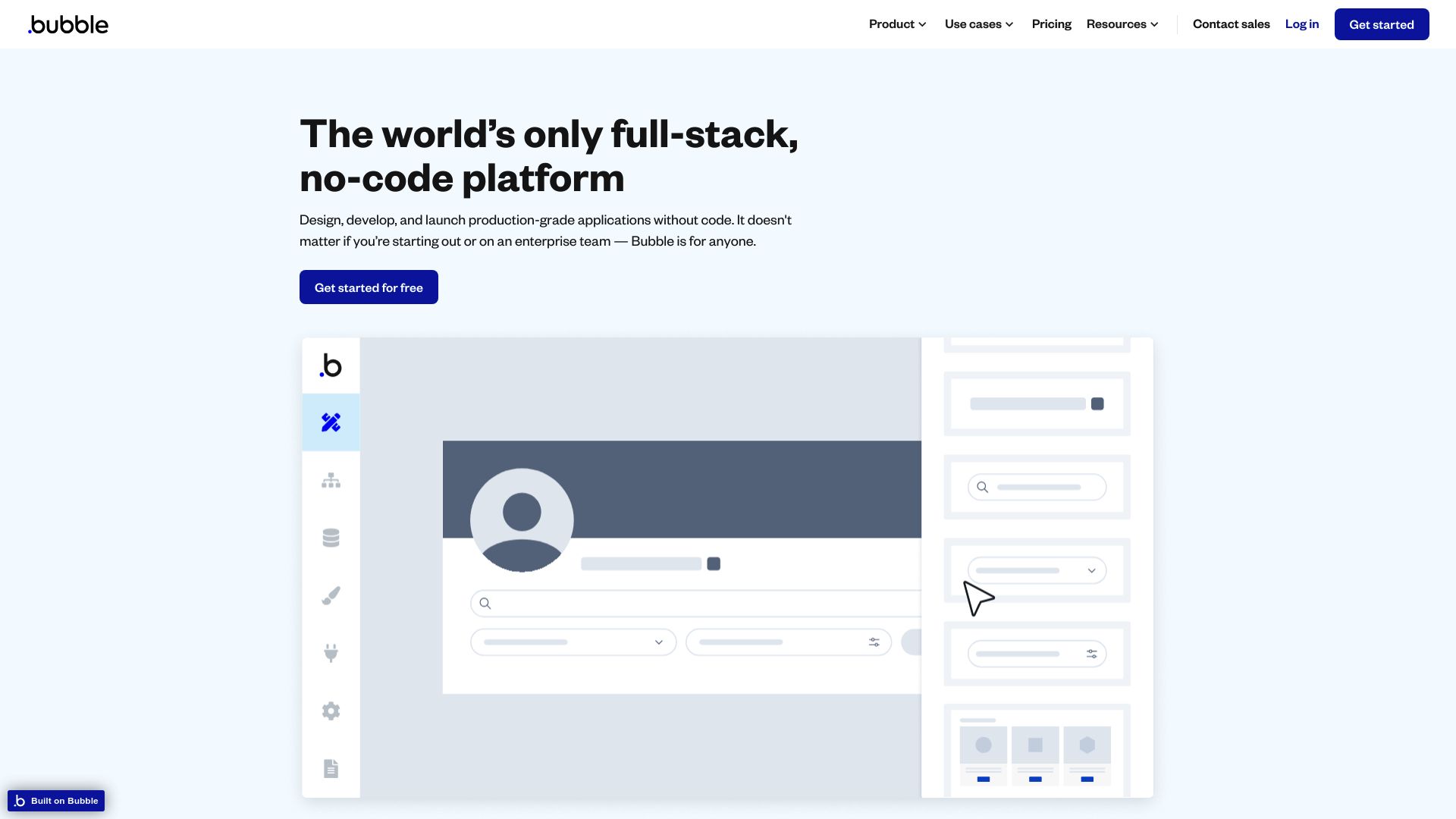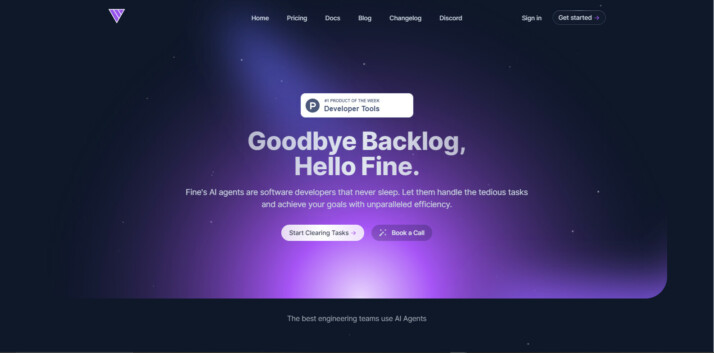Bubble vs. Fine AI: Comparing No-Code and AI-Assisted Development
AI-powered software development tools are reshaping how applications are built, deployed, and maintained. This comparison review examines Bubble, a no-code platform for web application development, and Fine AI, a system for creating specialized AI coding assistants. We’ll explore how these platforms address different aspects of the development process, from visual design to automated coding.
By analyzing their unique features, strengths, and limitations, we aim to help developers, business leaders, and entrepreneurs choose the right tool for their needs. We’ll also introduce SmythOS, a comprehensive AI development platform that combines visual building with advanced AI capabilities, offering a powerful alternative for those seeking to harness the full potential of AI in their software projects.
Bubble Overview
Bubble empowers users to create web applications without writing code. This visual development platform caters to entrepreneurs, small businesses, and enterprises seeking to rapidly build and deploy custom software solutions.
Bubble’s drag-and-drop interface allows users to design responsive layouts, define workflows, and manage databases through an intuitive visual editor. The platform supports integration with external APIs and services, enabling developers to incorporate advanced functionalities like AI-powered features into their applications.


Bubble’s strength lies in its accessibility for non-technical users while offering powerful customization options for more experienced developers. The platform provides both development and production environments, allowing teams to collaborate, test, and deploy applications seamlessly. Bubble’s infrastructure, built on Amazon Web Services, ensures scalability and robust security measures, including GDPR compliance and SOC 2 Type II certification.
Bubble empowers users to create web applications without writing code. This visual development platform caters to entrepreneurs, small businesses, and enterprises seeking to rapidly build and deploy custom software solutions.
While Bubble excels in web application development, it lacks some specialized AI agent features found in dedicated AI platforms. The platform does not offer built-in autonomous agents or advanced AI explainability tools. However, Bubble compensates by enabling integration with AI services through plugins and API connectors, allowing developers to incorporate AI functionalities like chatbots and content generation into their applications.
Bubble’s vision of democratizing software development aligns with the growing demand for no-code solutions in the tech industry. By lowering the barrier to entry for app creation, Bubble empowers a wider range of individuals and businesses to bring their ideas to life, fostering innovation across various sectors.
Fine AI Overview
Fine AI brings a fresh approach to software development automation. The platform empowers developers to create specialized AI agents that handle various aspects of coding, from backend tasks to frontend implementations and testing. These agents interpret specifications and make coherent changes across codebases, streamlining the development process.


Fine AI’s vision centers on transforming the developer workflow. By automating repetitive tasks, the platform allows engineers to focus on complex problem-solving and creative aspects of software development. This approach aims to boost productivity and restore the joy of building software by eliminating tedious coding tasks.
Fine AI’s vision centers on transforming the developer workflow. By automating repetitive tasks, the platform allows engineers to focus on complex problem-solving and creative aspects of software development.
The platform offers a desktop application for configuring workflows and agents, along with a library of pre-built agents for common tasks. Developers can run these agents locally on their repositories, providing flexibility and control. Fine AI also includes notebooks for authoring technical specifications, bridging the gap between project requirements and code implementation.
Fine AI distinguishes itself by emphasizing tailored agents aligned with developers’ specific technology stacks, rather than offering general-purpose assistants. This focus allows for more precise and effective automation within familiar development environments. The platform promotes human-AI collaboration, fostering collective problem-solving and enhancing the overall software development experience.
While Fine AI shows promise in revolutionizing developer workflows, it’s important to note that the platform is currently in public beta. This status suggests that users may encounter ongoing refinements and potential limitations as the product evolves. Additionally, the effectiveness of the AI agents in handling complex, real-world development scenarios remains to be fully proven in diverse production environments.
Feature Comparison
Bubble and Fine AI offer distinct approaches to software development, with notable feature gaps between them. Bubble focuses on no-code web application development, while Fine AI specializes in AI-powered coding assistance.
Bubble excels in visual development, providing a drag-and-drop interface for building web applications without writing code. It offers both development and production environments, allowing users to test and deploy applications seamlessly. However, Bubble lacks advanced AI agent capabilities, autonomous agents, and specialized features for software development automation.
Fine AI, on the other hand, centers on creating AI agents for automating coding tasks. It provides a desktop application for configuring workflows and a library of pre-built agents for common development tasks. Fine AI emphasizes human-AI collaboration in software development, but it doesn’t offer the visual building tools or no-code options that Bubble provides.
In terms of security, Bubble implements robust measures like TLS encryption and OAuth support, while Fine AI’s security features are not explicitly detailed in the available information. This highlights a potential gap in Fine AI’s offering for enterprise-level security requirements.
Feature Comparison Table
| Bubble | Fine AI | SmythOS | |
|---|---|---|---|
| CORE FEATURES | |||
| Hosted Agents (Dev, Production) | ✅ | ❌ | ✅ |
| Environments (Dev, Production) | ✅ | ❌ | ✅ |
| Visual Builder | ✅ | ❌ | ✅ |
| No-Code Options | ✅ | ❌ | ✅ |
| Memory & Context | ❌ | ✅ | ✅ |
| Autonomous Agents | ❌ | ✅ | ✅ |
| Explainability & Transparency | ❌ | ❌ | ✅ |
| Debug Tools | ✅ | ❌ | ✅ |
| Multimodal | ❌ | ❌ | ✅ |
| Multi-Agent Collaboration | ❌ | ❌ | ✅ |
| Audit Logs for Analytics | ✅ | ❌ | ✅ |
| Bulk Work | ❌ | ✅ | ✅ |
| Agent Work Scheduler | ❌ | ✅ | ✅ |
| SECURITY | |||
| Constrained Alignment | ❌ | ❌ | ✅ |
| Data Encryption | ✅ | ❌ | ✅ |
| OAuth | ✅ | ❌ | ✅ |
| IP Control | ❌ | ❌ | ✅ |
| COMPONENTS | |||
| Foundation AIs | ✅ | ❌ | ✅ |
| Huggingface AIs | ❌ | ❌ | ✅ |
| Zapier APIs | ✅ | ❌ | ✅ |
| All other APIs, RPA | ✅ | ❌ | ✅ |
| Classifiers | ❌ | ❌ | ✅ |
| Logic | ✅ | ❌ | ✅ |
| Data Lakes | ✅ | ❌ | ✅ |
| DEPLOYMENT OPTIONS (EMBODIMENTS) | |||
| Deploy as API | ❌ | ❌ | ✅ |
| Deploy as Webhook | ✅ | ❌ | ✅ |
| Staging Domains | ✅ | ❌ | ✅ |
| Production Domains | ✅ | ❌ | ✅ |
| API Authentication (OAuth + Key) | ✅ | ❌ | ✅ |
| Deploy as Site Chat | ✅ | ❌ | ✅ |
| Deploy as Scheduled Agent | ❌ | ❌ | ✅ |
| Deploy as GPT | ✅ | ❌ | ✅ |
| Scalability | ✅ | ❌ | ✅ |
| DATA LAKE SUPPORT | |||
| Hosted Vector Database | ❌ | ❌ | ✅ |
| Sitemap Crawler | ❌ | ❌ | ✅ |
| YouTube Transcript Crawler | ❌ | ❌ | ✅ |
| URL Crawler | ❌ | ❌ | ✅ |
| PDF Support | ✅ | ❌ | ✅ |
| Word File Support | ✅ | ❌ | ✅ |
| TXT File Support | ✅ | ❌ | ✅ |
Conclusion
Bubble and Fine AI offer distinct approaches to software development, each with unique strengths. Bubble excels in no-code web application creation, empowering users to build custom solutions without programming expertise. Fine AI focuses on AI-powered coding assistance, streamlining development workflows through specialized agents.
While both platforms innovate in their respective domains, they fall short in providing a comprehensive solution for AI-driven development and deployment. Bubble lacks advanced AI capabilities, and Fine AI’s beta status raises questions about its readiness for production environments.
SmythOS emerges as the superior choice, combining the best of both worlds with additional cutting-edge features. Our platform offers a visual builder for creating AI agents, extensive integration options, and flexible deployment capabilities. SmythOS supports multi-agent collaboration, provides robust security measures, and enables seamless scaling from development to production.
For businesses and developers seeking a powerful, all-in-one solution for AI-driven software creation, SmythOS stands out as the clear winner. Experience the future of AI development by creating a free SmythOS account today. Unlock the potential of over 300,000 integrations and deploy your AI agents anywhere with our platform. Start building intelligent, scalable applications that drive innovation and efficiency across your organization.
Last updated:
Disclaimer: The information presented in this article is for general informational purposes only and is provided as is. While we strive to keep the content up-to-date and accurate, we make no representations or warranties of any kind, express or implied, about the completeness, accuracy, reliability, suitability, or availability of the information contained in this article.
Any reliance you place on such information is strictly at your own risk. We reserve the right to make additions, deletions, or modifications to the contents of this article at any time without prior notice.
In no event will we be liable for any loss or damage including without limitation, indirect or consequential loss or damage, or any loss or damage whatsoever arising from loss of data, profits, or any other loss not specified herein arising out of, or in connection with, the use of this article.
Despite our best efforts, this article may contain oversights, errors, or omissions. If you notice any inaccuracies or have concerns about the content, please report them through our content feedback form. Your input helps us maintain the quality and reliability of our information.
